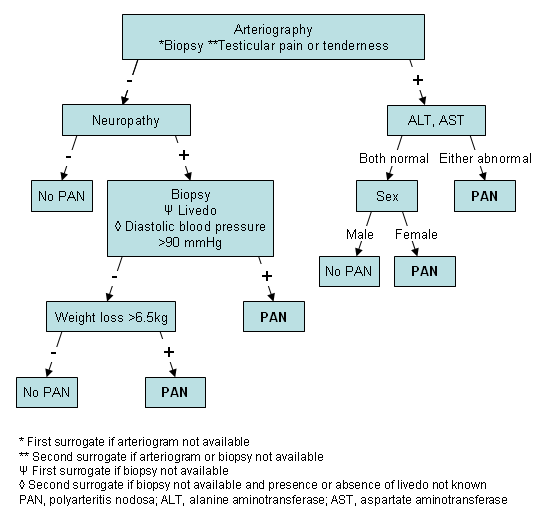Criteria
French Vasculitis Study Group (FVSG) proposal for diagnostic criteria for polyarteritis nodosa[9]
There are no validated diagnostic criteria for polyarteritis nodosa (PAN). The FVSG has proposed a set of predictive items to be used as a paradigm for diagnostic criteria. However, items were derived from patients with known vasculitis and not from undifferentiated patients, and this methodology is typically used to identify items used in classification rather than diagnostic criteria.
A total of eight discriminating items were derived from a cohort of 949 patients with vasculitis, 262 of whom had a diagnosis of PAN: three positive predictive items and five negative predictive items.
The positive predictive items were:
Positivity for hepatitis B virus infection
Arteriographic abnormalities
Mononeuropathy or polyneuropathy.
The negative predictive items were:
Presence of anti-neutrophil cytoplasmic antibodies (ANCA)
Asthma
Ear, nose, or throat signs
Glomerulopathy
Cryoglobulinaemia.
These items were useful to differentiate between PAN and other vasculitides in this cohort, but have not been evaluated in undifferentiated patients to see whether they would be useful for diagnostic purposes.
The American College of Rheumatology (ACR) 1990 criteria for the classification of polyarteritis nodosa[3]
These criteria are used to classify which patients with known primary systemic vasculitis have PAN. These criteria do not differentiate between PAN and microscopic polyangiitis (MPA); both are included under the umbrella of PAN. Three of the following 10 criteria are required:
Weight loss ≥4 kg
Livedo reticularis
Testicular pain or tenderness
Myalgias, weakness, or leg tenderness
Mononeuropathy or polyneuropathy
Diastolic blood pressure >90 mmHg
Elevated urea or creatinine
Positivity for hepatitis B virus (HBV) infection
Arteriographic abnormality
Biopsy of small- or medium-sized artery containing polymorphonuclear leukocytes.
The sensitivity of these criteria is 82.2% and the specificity 86.6% when used in this context.[3] This was calculated from the cohort used to develop the criteria, and has not been prospectively validated. [Figure caption and citation for the preceding image starts]: American College of Rheumatology 1990 criteria for PANAdapted by the authors from Lightfoot RW Jr, Michel BA, Bloch DA, et al. The American College of Rheumatology 1990 criteria for the classification of polyarteritis nodosa. Arthritis Rheum. 1990;33:1088-1093 [Citation ends].
European Medicines Agency (EMA) algorithm for the classification of the ANCA-associated vasculitides and polyarteritis nodosa for epidemiological studies[4]
This is an algorithm to apply the disease definitions and classification criteria for the anti-neutrophil cytoplasmic antibodies (ANCA)-associated vasculitides and PAN in a stepwise manner. The algorithm is useful because MPA is absent in the ACR classification criteria (which consider it to be part of PAN), whereas in the Chapel Hill Consensus Conference (CHCC) definition PAN and MPA are treated as separate entities, and there is evidence that they behave differently in terms of pathogenesis, organ involvement, tendency to relapse, and prognosis.[5] In the CHCC definition, PAN is strictly a medium-vessel disease whereas MPA is predominantly a small-vessel disease that includes glomerulonephritis and pulmonary capillaritis.[2]
Entry into the algorithm is by having a clinical diagnosis of an ANCA-associated vasculitis or PAN. In the algorithm, PAN is a diagnosis of exclusion.
The first step is to determine whether the patient fulfils the Lanham[6] or ACR criteria[7] for Churg-Strauss syndrome (CSS). If so, the patient is classified as having CSS.
If not, the next step is to determine whether the patient fulfils the ACR criteria[8] or the CHCC definition for granulomatosis with polyangiitis (Wegener's) (GPA),[2] either by direct evidence with histology or with appropriate surrogate markers and a positive ANCA. If the patient fulfils these criteria, he or she is classified as having GPA.
If not, see whether the patient fulfils a definition of MPA.[2] This is either by histology showing small-vessel vasculitis or glomerulonephritis and no surrogate markers for GPA, or with surrogate markers of glomerulonephritis and a positive ANCA.
Only when CSS, GPA, and MPA have been excluded is a diagnosis of PAN possible.
To fulfil the definition of PAN, there must be histology or angiographic features consistent with the diagnosis. Any remaining patients are determined to be unclassifiable.
Use of this content is subject to our disclaimer